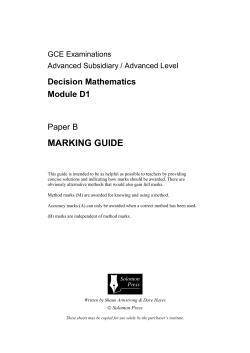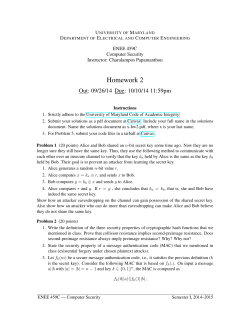
MATH3302 – Sample Mid-Semester Examination Part A
MATH3302 – Sample Mid-Semester Examination
Part A
For each of the following multiple choice questions, circle the letter(s) corresponding to the
correct answer(s). The number of correct answers is clearly indicated in each question. Each
question having ONE correct answer is worth 1 mark. Each question having TWO correct
answers is worth 2 marks.
1. Which ONE of the following integers does not have an inverse in Z26 ?
(a) 3
(b) 7
(c) 13
(d) 19
(e) 21
2. Using an affine cipher with the key K = (a, b) = (3, 16), which ONE of the following
letters is the ciphertext corresponding to the plaintext letter e?
(a) B
(b) C
(c) E
(d) F
(e) M
3. Using the Playfair cipher with the following 5 × 5 array, which ONE of the following is
the ciphertext corresponding to the plaintext hi?
C
G
T
K
U
(a) OE
(b) AY
O D I/J N
A R Y
P
H B E F
L M Q S
V W X Z
(c) EO
(d) BN
(e) TD
4. Using a row transposition cipher with the key π = (134)(25), which ONE of the following
is the ciphertext corresponding to the plaintext lucky?
(a) CYKLU
(b) KYLCU
(c) LYKCU
(d) CUKLY
(e) YKCUL
5. Using the ADFGVX cipher with the following substitution array and the keyword football,
which ONE of the following is the ciphertext corresponding to the plaintext try?
A
D
F
G
V
X
A D F G V X
a b c d e f
g h i j k l
m n o p q r
s t u v w x
y z 0 1 2 3
4 5 6 7 8 9
(a) GDF XV A
(b) XV AGF D
(d) DGV AF X
(e) V XGADF
(c) AF DV GX
2
MATH3302 – Sample Mid-Semester Examination
6. Let the plaintext space and ciphertext space be the 26 letters of the English language.
Which TWO of the following cryptosystems do not have perfect secrecy?
(a) A general mixed alphabet in which all 26! keys are equally likely.
(b) A modified shift cipher with keyspace {1, 2, . . . , 25} in which all 25 keys are
equally likely.
(c) A shift cipher in which all 26 keys are equally likely.
(d) A shift cipher in which all even keys are used with probability 3/52 and all
odd keys are used with probability 1/52.
Recall that IDEA uses the operations ⊕, and which are defined as bitwise exclusive or,
addition modulo 2n and multiplication modulo 2n + 1, respectively, where the n-bit blocks are
considered as their integer values for and and the integer 2n is represented by the n-bit
block of zeros for . For the following three questions, n = 4.
7. Which ONE of the following gives the value of 1101 ⊕ 1110?
(a) 0010
(b) 1100
(c) 0011
(d) 1011
8. Which ONE of the following gives the value of 1110 0101?
(a) 0001
(b) 1100
(c) 1000
(d) 0011
9. Which ONE of the following gives the value of 1100 0011?
(a) 0010
(b) 1000
(c) 0100
3
(d) 0111
MATH3302 – Sample Mid-Semester Examination
Part B
Answer each of the following questions in the space provided. (Note that the space has been
deleted to save paper for this sample exam.) The number of marks allocated to each question
appears on the right.
10. (a) Briefly describe what is meant by the word cryptography.
(2 marks)
(b) List 5 properties that a cryptosystem should have to be considered a good cryptosystem.
(5 marks)
9 4
11. Let C = P = Z26 , and let the encryption key for the Hill Cipher be K =
.
1 3
Find the plaintext which encrypts to the ciphertext
AB
cipher and the key K. (Hint: first find the decryption key K −1 .)
when using the Hill
(5 marks)
12. (a) Briefly describe the Vigenere cipher, including a discussion of the encryption and
decryption processes.
(3 marks)
(b) The following partial output was obtained by analysing some ciphertext from English
plaintext. The first table gives some of the repeated strings found in the ciphertext,
and the character positions within the ciphertext of the start of each of the repeated
strings. The second table gives values of Friedman’s Index of Coincidence (IC)
obtained for potential values of the keyword length m ranging from 1 to 6.
String
ejqe
kbml
vbrd
xgmlb
mlbqk
fgt
oatra
Locations
177 237
306 330
419 459
150 206
152 308 336
244 345
346 426
m
1
2
3
4
5
6
IC
0.0480
0.0513
0.0508
0.0671
0.0507
0.0486
0.0582
0.0487
0.0696
0.0384
0.0572
0.0450
0.0683 0.0646
0.0436 0.0470 0.0538
0.0489 0.0588 0.0555 0.0634
(i) What information from these tables suggests that encryption was not done
using a General Mixed Alphabet? (Explain your answer briefly.)
(2 marks)
(ii) Using Kasiski’s test, what is the most probable keyword length m used in the
encryption? (Explain your answer briefly.)
(2 marks)
(iii) Using Friedman’s test (method 1), what is the most probable keyword length m
used in the encryption? (Explain your answer briefly.)
(2 marks)
4
MATH3302 – Sample Mid-Semester Examination
13. Consider a 4-stage LFSR stream cipher with initial key (k1 , k2 , k3 , k4 ) and keystream
l1 , l2 , l3 . . . generated by lj = kj for j = 1, 2, 3, 4 and
li+4 = c0 li + c1 li+1 + c2 li+2 + c3 li+3
for i = 1, 2, 3 . . . .
(a) Explain why the linear recurrence relation li+4 = li+1 + li+3 would be a poor choice.
(2 marks)
(b) Suppose Oscar knows that a 4-stage LRSR stream cipher was used to encrypt the
plaintext 101010101010 to obtain the ciphertext 001001011111. Determine the linear
recurrence relation used.
(5 marks)
14. Consider a cryptosystem with P = {a, b, c}, K = {k1 , k2 , k3 } and C = {A, B, C, D}. Let
pP (a) = pP (b) = pP (c) = 1/3 and let pK (k1 ) = 1/2, pK (k2 ) = 1/3 and pK (k3 ) = 1/6. Let
the encryption function be defined as ek (x) is the entry in row k and column x of the
following table.
a b c
k1 B C D
k2 C D A
k3 D A B
(a) Determine pC (A).
(3 marks)
(b) Determine pP (b|A).
(3 marks)
15. (a) Describe what is meant by a ‘Feistel Cipher’.
(3 marks)
(b) DES includes S-boxes as part of its encryption and decryption steps. Each of eight
S-boxes is a fixed 4 × 16 array, whose entries come from the integers 0, 1, . . . , 15.
Describe in detail how DES transforms a 48 bit string into a 32 bit string using the
S-boxes.
(5 marks)
(c) Without giving details of the algorithm, briefly discuss some of the shortcomings of
DES.
(2 marks)
5
MATH3302 – Sample Mid-Semester Examination
16. The Advanced Encryption Standard (AES) includes the operations addition, written +,
and multiplication, written ∗, performed over the Galois Field of order 256, written
GF[256].
(a) Elements of GF[256] can be written as bitstrings, as polynomials, and using hexadecimal notation. Write the element {4e} in bitstring and polynomial form.
(2 marks)
(b) Multiplication in the AES uses the irreducible polynomial
m(x) = x8 + x4 + x3 + x + 1.
Evaluate {01000011} ∗ {00010100} and give your answer as a bitstring. (You may
use any method that you like.)
(4 marks)
17. For the RSA algorithm, prove that if you encrypt a message x ∈ Zn and then decrypt the
result, you obtain x ∈ Zn ; that is, prove the following statement.
If x ∈ Zn , then (xb )a = x (mod n)
where a, b, n are as defined for the RSA algorithm.
(5 marks)
6
MATH3302 – Sample Mid-Semester Examination
Reference Page
a,A b,B c,C d,D
0
1
2
3
n,N o,O p,P q,Q
13
14
15
16
e,E f,F g,G h,H
4
5
6
7
r,R s,S t,T u,U
17 18 19
20
i,I
j,J k,K
8
9
10
v,V w,W x,X
21
22
23
l,L
11
y,Y
24
m,M
12
z,Z
25
Tables 2 and 3 from the AES specification paper
L(xy)
y
0
x
0
1
2
3
4
5
6
7
8
9
a
b
c
d
e
f
64
7d
65
96
66
7e
2b
af
2c
7f
cc
97
53
44
67
Table
E(xy)
x
0
1
2
3
4
5
6
7
8
9
a
b
c
d
e
f
1
2
00 19
04 e0
c2 1d
2f 8a
8f db
dd fd
6e 48
79 0a
58 a8
d7 75
0c f6
bb 3e
b2 87
39 84
11 92
4a ed
2 Logs: L
3
4
5
6
7
8
9
a
b
c
d
e
f
01 32 02 1a c6 4b c7 1b 68 33 ee df 03
0e 34 8d 81 ef 4c 71 08 c8 f8 69 1c c1
b5 f9 b9 27 6a 4d e4 a6 72 9a c9 09 78
05 21 0f e1 24 12 f0 82 45 35 93 da 8e
bd 36 d0 ce 94 13 5c d2 f1 40 46 83 38
30 bf 06 8b 62 b3 25 e2 98 22 88 91 10
c3 a3 b6 1e 42 3a 6b 28 54 fa 85 3d ba
15 9b 9f 5e ca 4e d4 ac e5 f3 73 a7 57
50 f4 ea d6 74 4f ae e9 d5 e7 e6 ad e8
7a eb 16 0b f5 59 cb 5f b0 9c a9 51 a0
6f 17 c4 49 ec d8 43 1f 2d a4 76 7b b7
5a fb 60 b1 86 3b 52 a1 6c aa 55 29 9d
90 61 be dc fc bc 95 cf cd 37 3f 5b d1
3c 41 a2 6d 47 14 2a 9e 5d 56 f2 d3 ab
d9 23 20 2e 89 b4 7c b8 26 77 99 e3 a5
de c5 31 fe 18 0d 63 8c 80 c0 f7 70 07
values such that {xy} = {03}L for a given a finite field element {xy}
y
0
01
5f
e5
53
4c
83
b5
fe
fb
c3
9f
9b
fc
45
12
39
Table
1
2
3
4
5
6
7
8
9
a
b
c
d
e
f
03 05 0f 11 33 55 ff 1a 2e 72 96 a1 f8 13 35
e1 38 48 d8 73 95 a4 f7 02 06 0a 1e 22 66 aa
34 5c e4 37 59 eb 26 6a be d9 70 90 ab e6 31
f5 04 0c 14 3c 44 cc 4f d1 68 b8 d3 6e b2 cd
d4 67 a9 e0 3b 4d d7 62 a6 f1 08 18 28 78 88
9e b9 d0 6b bd dc 7f 81 98 b3 ce 49 db 76 9a
c4 57 f9 10 30 50 f0 0b 1d 27 69 bb d6 61 a3
19 2b 7d 87 92 ad ec 2f 71 93 ae e9 20 60 a0
16 3a 4e d2 6d b7 c2 5d e7 32 56 fa 15 3f 41
5e e2 3d 47 c9 40 c0 5b ed 2c 74 9c bf da 75
ba d5 64 ac ef 2a 7e 82 9d bc df 7a 8e 89 80
b6 c1 58 e8 23 65 af ea 25 6f b1 c8 43 c5 54
1f 21 63 a5 f4 07 09 1b 2d 77 99 b0 cb 46 ca
cf 4a de 79 8b 86 91 a8 e3 3e 42 c6 51 f3 0e
36 5a ee 29 7b 8d 8c 8f 8a 85 94 a7 f2 0d 17
4b dd 7c 84 97 a2 fd 1c 24 6c b4 c7 52 f6 01
3 Antilogs: field elements {E} such that {E} = {03}{xy} given the power {xy}
7
© Copyright 2025





















